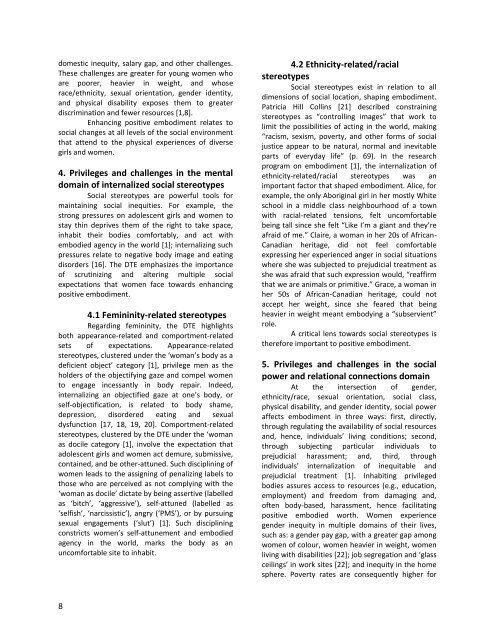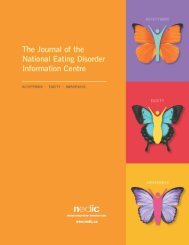NEDIC Conference Journal 2018
You also want an ePaper? Increase the reach of your titles
YUMPU automatically turns print PDFs into web optimized ePapers that Google loves.
domestic inequity, salary gap, and other challenges.<br />
These challenges are greater for young women who<br />
are poorer, heavier in weight, and whose<br />
race/ethnicity, sexual orientation, gender identity,<br />
and physical disability exposes them to greater<br />
discrimination and fewer resources [1,8].<br />
Enhancing positive embodiment relates to<br />
social changes at all levels of the social environment<br />
that attend to the physical experiences of diverse<br />
girls and women.<br />
4. Privileges and challenges in the mental<br />
domain of internalized social stereotypes<br />
Social stereotypes are powerful tools for<br />
maintaining social inequities. For example, the<br />
strong pressures on adolescent girls and women to<br />
stay thin deprives them of the right to take space,<br />
inhabit their bodies comfortably, and act with<br />
embodied agency in the world [1]; internalizing such<br />
pressures relate to negative body image and eating<br />
disorders [16]. The DTE emphasizes the importance<br />
of scrutinizing and altering multiple social<br />
expectations that women face towards enhancing<br />
positive embodiment.<br />
4.1 Femininity-related stereotypes<br />
Regarding femininity, the DTE highlights<br />
both appearance-related and comportment-related<br />
sets of expectations. Appearance-related<br />
stereotypes, clustered under the ‘woman’s body as a<br />
deficient object’ category [1], privilege men as the<br />
holders of the objectifying gaze and compel women<br />
to engage incessantly in body repair. Indeed,<br />
internalizing an objectified gaze at one’s body, or<br />
self-objectification, is related to body shame,<br />
depression, disordered eating and sexual<br />
dysfunction [17, 18, 19, 20]. Comportment-related<br />
stereotypes, clustered by the DTE under the ‘woman<br />
as docile category [1], involve the expectation that<br />
adolescent girls and women act demure, submissive,<br />
contained, and be other-attuned. Such disciplining of<br />
women leads to the assigning of penalizing labels to<br />
those who are perceived as not complying with the<br />
‘woman as docile’ dictate by being assertive (labelled<br />
as ‘bitch’, ‘aggressive’), self-attuned (labelled as<br />
‘selfish’, ‘narcissistic’), angry (‘PMS’), or by pursuing<br />
sexual engagements (‘slut’) [1]. Such disciplining<br />
constricts women’s self-attunement and embodied<br />
agency in the world, marks the body as an<br />
uncomfortable site to inhabit.<br />
4.2 Ethnicity-related/racial<br />
stereotypes<br />
Social stereotypes exist in relation to all<br />
dimensions of social location, shaping embodiment.<br />
Patricia Hill Collins [21] described constraining<br />
stereotypes as “controlling images” that work to<br />
limit the possibilities of acting in the world, making<br />
“racism, sexism, poverty, and other forms of social<br />
justice appear to be natural, normal and inevitable<br />
parts of everyday life” (p. 69). In the research<br />
program on embodiment [1], the internalization of<br />
ethnicity-related/racial stereotypes was an<br />
important factor that shaped embodiment. Alice, for<br />
example, the only Aboriginal girl in her mostly White<br />
school in a middle class neighbourhood of a town<br />
with racial-related tensions, felt uncomfortable<br />
being tall since she felt “Like I’m a giant and they’re<br />
afraid of me.” Claire, a woman in her 20s of African-<br />
Canadian heritage, did not feel comfortable<br />
expressing her experienced anger in social situations<br />
where she was subjected to prejudicial treatment as<br />
she was afraid that such expression would, “reaffirm<br />
that we are animals or primitive.” Grace, a woman in<br />
her 50s of African-Canadian heritage, could not<br />
accept her weight, since she feared that being<br />
heavier in weight meant embodying a “subservient”<br />
role.<br />
A critical lens towards social stereotypes is<br />
therefore important to positive embodiment.<br />
5. Privileges and challenges in the social<br />
power and relational connections domain<br />
At the intersection of gender,<br />
ethnicity/race, sexual orientation, social class,<br />
physical disability, and gender identity, social power<br />
affects embodiment in three ways: first, directly,<br />
through regulating the availability of social resources<br />
and, hence, individuals’ living conditions; second,<br />
through subjecting particular individuals to<br />
prejudicial harassment; and, third, through<br />
individuals’ internalization of inequitable and<br />
prejudicial treatment [1]. Inhabiting privileged<br />
bodies assures access to resources (e.g., education,<br />
employment) and freedom from damaging and,<br />
often body-based, harassment, hence facilitating<br />
positive embodied worth. Women experience<br />
gender inequity in multiple domains of their lives,<br />
such as: a gender pay gap, with a greater gap among<br />
women of colour, women heavier in weight, women<br />
living with disabilities [22]; job segregation and ‘glass<br />
ceilings’ in work sites [22]; and inequity in the home<br />
sphere. Poverty rates are consequently higher for<br />
8




